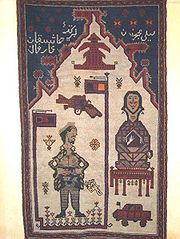
War rugs
Encyclopedia

Afghanistan
Afghanistan , officially the Islamic Republic of Afghanistan, is a landlocked country located in the centre of Asia, forming South Asia, Central Asia and the Middle East. With a population of about 29 million, it has an area of , making it the 42nd most populous and 41st largest nation in the world...
has its origins in the decade of Soviet occupation of Afghanistan from 1979
Soviet war in Afghanistan
The Soviet war in Afghanistan was a nine-year conflict involving the Soviet Union, supporting the Marxist-Leninist government of the Democratic Republic of Afghanistan against the Afghan Mujahideen and foreign "Arab–Afghan" volunteers...
, and has continued through subsequent military, political and social conflicts. Afghan rug-makers began incorporating the apparatus of war into their designs almost immediately after the Soviet Union
Soviet Union
The Soviet Union , officially the Union of Soviet Socialist Republics , was a constitutionally socialist state that existed in Eurasia between 1922 and 1991....
invaded their country. They continue to do so today in the wake of the United States
United States
The United States of America is a federal constitutional republic comprising fifty states and a federal district...
' 2001 invasion of Afghanistan
War in Afghanistan (2001–present)
The War in Afghanistan began on October 7, 2001, as the armed forces of the United States of America, the United Kingdom, Australia, and the Afghan United Front launched Operation Enduring Freedom...
which ousted the Taliban government of Mullah Omar
Mohammed Omar
Mullah Mohammed Omar , often simply called Mullah Omar, is the leader of the Taliban movement that operates in Afghanistan. He was Afghanistan's de facto head of state from 1996 to late 2001, under the official title "Head of the Supreme Council"...
but has failed to bring an end to violence in the country
Taliban insurgency
The Taliban insurgency took root shortly after the group's fall from power following the 2001 war in Afghanistan. The Taliban continue to attack Afghan, U.S., and other ISAF troops and many terrorist incidents attributable to them have been registered. The war has also spread over the southern and...
. The rugs produced in response to these events are among the world's richest traditions of war art of the late 20th and early 21st centuries.
The terms Baluch and war rug are generalisations given to the genre by rug dealers, commercial galleries, collectors, critics and commentators. The distinctive characteristic of these rugs is their capacity to convey their makers' experiences and interpretations of the circumstances and politics of war and conflict in the region.
Little is known about the circumstances of war rugs' production and distribution, or their makers' intentions.
Literature
Jürgen Wasim Frembgen and Hans Werner Mohm: Lebensbaum und Kalaschnikow. Krieg und Frieden im Spiegel afghanischer Bildteppiche, Gollenstein Verlag (publishers), Blieskastel (in Germany), 2000. This is the first known serious and detailed study of any substance in the field of the so-called "War Rugs" from AfghanistanExternal links
- Fyke Collection of Afghan War Rugs is a digital collection of 48 textiles produced by Afghan weavers in response to three decades of war. The rugs were donated to The Nickle Arts Museum at the University of Calgary by Robert Fyke (July 1966 - Jan. 2009)
- the rugsofwar weblog at the Australian National UniversityAustralian National UniversityThe Australian National University is a teaching and research university located in the Australian capital, Canberra.As of 2009, the ANU employs 3,945 administrative staff who teach approximately 10,000 undergraduates, and 7,500 postgraduate students...
includes a range of images and comprehensive links and a comprehensive bibliography.
- Rolf Sachsse: Geknüpfter und gewebter Krieg. Militärische Motive auf afghanischen Teppichen, in:Zeithistorische Forschungen/Studies in Contemporary History, Online-Edition, Vol. 3, Nr. 2, 2006 http://www.zeithistorische-forschungen.de/16126041-Sachsse-2-2006 In German.
- Transitional art War rugs.

